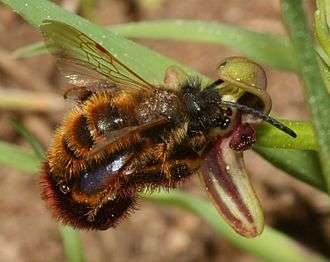Allomone
An allomone (from Ancient Greek ἄλλος allos "other" and pheromone) is any chemical substance produced and released by an individual of one species that affects the behaviour of a member of another species to the benefit of the originator but not the receiver.[1] Production of allomones is a common form of defence, particularly by plant species against insect herbivores.

Many insects have developed ways to defend against these plant defenses (in an evolutionary arms race). One method of adapting to allomones is to develop a positive reaction to them; the allomone then becomes a kairomone. Others alter the allomones to form pheromones or other hormones, and yet others adopt them into their own defensive strategies, for example by regurgitating them when attacked by an insectivorous insect.
A third class of allelochemical (chemical used in interspecific communication), synomones, benefit both the sender and receiver.[1]
"Allomone was proposed by Brown and Eisner (Brown, 1968) to denote those substances which convey an advantage upon the emitter. Because Brown and Eisner did not specify whether or not the receiver would benefit, the original definition of allomone includes both substances that benefit the receiver and the emitter, and substances that only benefit the emitter. An example of the first relationship would be a mutualistic relationship, and the latter would be a repellent secretion."[2]
Examples
Disrupt growth and development and reduce longevity of adults e.g. toxins or digestibility reducing factors.
- Antixenotics
Disrupt normal host selection behaviour e.g. Repellents, suppressants, locomotory excitants.
Plants producing allomones
- Desmodium (tick-trefoils)
Insects producing allomones
- The larvae of the berothid lacewing Lomamyia latipennis feed on termites which they subdue with an aggressive allomone. The first instar approaches a termite and waves the tip of its abdomen near the termite's head. The termite becomes immobile after 1 to 3 minutes, and completely paralysed very soon after this, although it may live for up to 3 hours. The berothid then feeds on the paralysed prey. The third instar feeds in a similar manner and may kill up to six termites at a time. Contact between the termite and the berothid is not necessary for subduing, and other insects present are not affected by the allomone.[3]
See also
References
- Grasswitz, T.R. and G.R. Jones (2002). "Chemical Ecology". Encyclopedia of Life Sciences. John Wiley & Sons, Ltd. doi:10.1038/npg.els.0001716.
- Weldon, Paul J. Journal of Chemical Ecology. p. 719. doi:10.1007/BF00987681.
- Insects as Predators by T New, published by NSW University Press in 1991